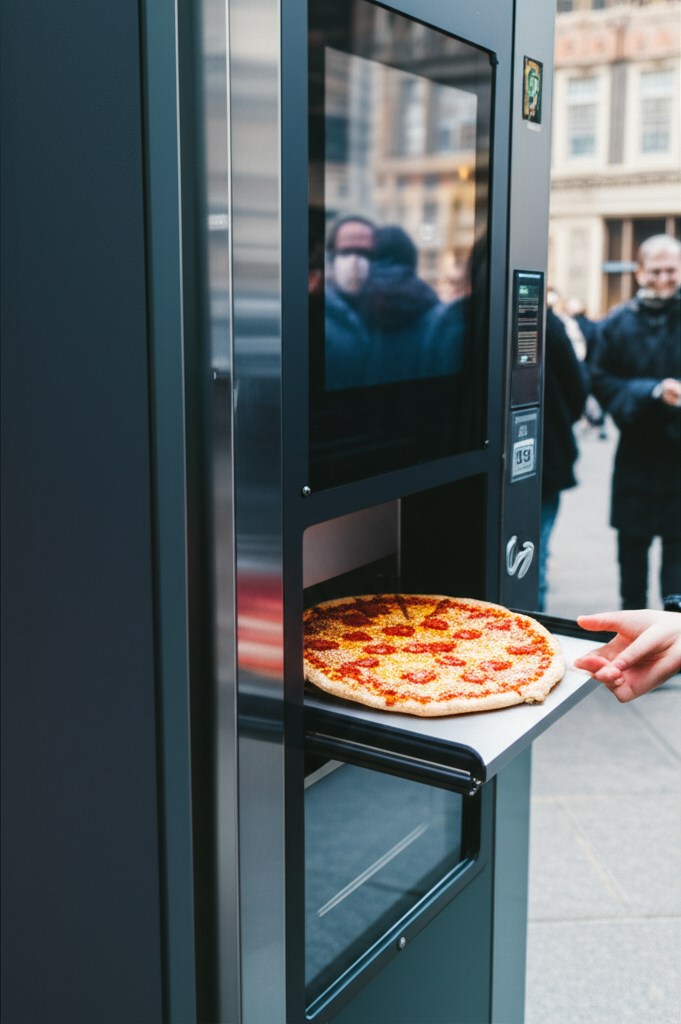Introduction
Think of a vending machine. You probably picture snacks, sodas, maybe coffee. They’re everywhere, offering quick convenience in mundane moments. But what if that same box-like machine dispensed hot meals, luxury items, or even live fishing bait? The world of automated retail extends far beyond your average candy bar dispenser, delving into the truly bizarre and unexpected. You might be surprised by what you can grab on the go, from fresh baguettes to gold bars via automated systems similar to those discussed on sites exploring automated retail solutions.
This article explores some of the most unique, strange, and surprising vending machines you can find across the globe. We’ll journey through different continents, uncovering automated wonders that cater to niche needs and wild whims.
This journey isn’t just about novelty. These machines represent convenience pushed to new limits, fascinating cultural adaptations, clever technological innovation, and smart solutions for very specific market demands.
Get ready to discover automated dispensers offering everything from emergency essentials to high-tech gadgets, proving that almost anything can be bought with the push of a button and a swipe of a card. We’ll touch on the ‘weird facts’ behind their existence and the ‘tech’ that makes them possible.

Vending’s Evolutionary Journey: From Stamps to Strange Goods
The concept of automated dispensing isn’t new. The earliest known vending machine dates back to the 1st century AD in Alexandria, designed by Hero to dispense holy water after a coin was inserted. Fast forward to the Industrial Revolution, and mechanical vending saw a resurgence, dispensing postcards and books. The 20th century solidified the image of vending as we know it, with machines selling cigarettes, soda, and packaged snacks becoming commonplace.
Automation and mechanical engineering advancements were key. These innovations allowed machines to handle various coin types, provide change, and reliably dispense different product shapes and sizes. This paved the way for dispensing items more complex than a simple pack of gum.
The rise of niche and specialized vending machines is a direct progression. It’s driven by both changing consumer needs for speed and availability, and the ever-increasing capabilities of technology. As engineers solved how to vend one thing, they applied that knowledge to others.
So, what makes a vending machine “unique” or “bizarre”? It’s about stepping outside our common expectation. If a machine sells something you’d typically buy from a person, requires complex handling (like hot food or fragile items), or caters to a very specific, unusual need, it fits the bill.
Global Grab-and-Go: Exploring the World’s Weirdest & Most Unique Vending Machines
The world is dotted with automated dispensers offering goods far beyond the standard candy bar. From bustling city streets to quiet rural corners, these machines reflect local culture, climate, and consumer demands.
Japan’s Limitless Innovation in Automation
Japan is often considered the vending machine capital of the world. It boasts an incredibly high density and vast variety of machines per capita. This prevalence is partly due to Japan’s low crime rates, high population density, and demand for convenience, especially late at night.
Japanese machines sell an astonishing array of items. You can find hot ramen, freshly fried chicken, takoyaki (octopus balls), dashi broth for cooking, and even hot drinks in cans. Other unique items include umbrellas, fresh flowers, omikuji (fortune slips) at temples, electronics components, and reportedly even used underwear (though this is controversial and less common now).
European Surprises: Luxury, Essentials, and Local Flavors
Europe presents its own unique vending landscape, often blending luxury with practical essentials. You can buy gold bars from machines in London or Germany. France offers automated baguette dispensers, ensuring fresh bread even when bakeries are closed. Along popular cycling routes, machines provide spare inner tubes and basic bike repair parts.
Many rural European areas feature vending machines selling farm-fresh goods like eggs, milk, cheese, or seasonal produce directly from the farm. These cater to local needs and support agricultural producers.
North America’s Unexpected Offerings
North America has embraced the unique vending trend, often focusing on high-demand novelty or convenience items. Cupcake ATMs dispense freshly baked treats. Machines offer hot pizza or hot dogs in urban centers. Near fishing spots, you might find machines selling bait and tackle.
Emergency supplies like first-aid kits can be found in some locations. Art vending machines dispense small, original pieces from local artists. Some machines near beaches even sell flip-flops or sunscreen.

Beyond the Usual Suspects: Rest of the World’s Oddities
Other parts of the world showcase vending adapted to specific environments. Australia has machines dispensing sunscreen, a sensible solution for sun-drenched locations. In Singapore and the UAE, multi-story towers act as automated luxury car “vending machines,” retrieving purchased vehicles for customers – a high-tech storage and delivery system. You might also find machines selling PPE in high-traffic zones or essentials in remote locations.
Here are some examples:
| Item | Location | Notes |
|---|---|---|
| Hot Food (Ramen) | Japan | Freshly prepared or heated |
| Gold Bars | Europe (UK/DE) | Catering to high-value market |
| Fresh Baguettes | France | 24/7 bakery access |
| Bicycle Parts | Europe (Routes) | Emergency repairs |
| Farm Fresh Eggs | Rural Europe | Direct from producer |
| Cupcakes | North America (US) | Novelty dessert machines |
| Sunscreen | Australia | Essential for sun safety |
| Luxury Cars | Singapore/UAE | Automated storage/retrieval |
The Brains Behind the Box: Technology Enabling the Unique Vending Experience
Moving beyond the fascinating products, it’s the technology that truly brings these unique vending machines to life. They are far more complex than simple drop mechanisms.
Modern unique vending relies on advanced systems. Payment is seamless, with contactless, mobile payments (like Apple Pay or Google Pay), and even cryptocurrency acceptance becoming more common. Some cutting-edge systems explore biometric options.
Handling diverse items requires sophisticated internal mechanics. Robotic arms carefully pick and place fragile items like flowers or eggs. Temperature control systems maintain hot food at safe temperatures or keep drinks chilled. Custom dispensing mechanisms are designed for odd shapes or delicate goods.
Inventory management and monitoring are often handled remotely. IoT sensors track stock levels in real-time, accessible via cloud connectivity. This allows operators to know exactly what’s inside and when restocking is needed. Predictive maintenance alerts can flag potential issues before a machine breaks down, ensuring reliability – a key tech fact.
Security features like cameras and secure payment processing protect both the machine and the customer’s transaction data. User interfaces have evolved into intuitive touch screens, often offering multi-language options and even personalization features based on past purchases. These technologies collectively overcome the challenges of vending non-traditional items, ensuring quality and a smooth customer experience.
Why Go Unique? The Logic Behind Bizarre Vending Ideas
The decision to create a vending machine that dispenses something unusual isn’t random; it’s often driven by clear logic and market opportunities. Several factors contribute to the rise of unique vending solutions.
Convenience is a primary driver. Unique machines offer 24/7 access to items you might not find in traditional stores outside of business hours, whether it’s a late-night baguette or emergency fishing bait at dawn.
They serve market niches that might be too small or specialized for a full retail store. These machines can cater directly to a dedicated customer base with highly targeted products.
Vending can significantly reduce overhead. Compared to operating a traditional brick-and-mortar store, machines require less labor, lower rental costs for their footprint, and simpler operating expenses.
Novelty and marketing play a big role. A unique vending machine attracts attention, generates buzz on social media, and creates a memorable experience for customers, acting as a unique gadget or attraction.
Cultural and situational factors are also crucial. Machines adapt to local customs (like fortune slips in Japan), environments (like sunscreen on a beach), or specific urgent needs (like emergency supplies).
Finally, efficiency is key. For high-demand items in specific, high-traffic locations, vending provides quick, frictionless access, benefiting both the buyer and the seller.
The Future of Automated Retail: What’s Next for Vending?
The evolution of vending machines is far from over. The future of automated retail points towards even more integration, personalization, and complexity.
We might see increased personalization and AI integration. Machines could recommend products based on purchase history or demographics. Dynamic pricing could adjust based on demand or time of day. AI might power more sophisticated customer interactions.
Future machines could incorporate robotic preparation. Imagine machines that cook fresh meals on demand, assembling ingredients and serving a hot dish right there.
Vending machines could integrate into smart city infrastructure, perhaps serving as convenient last-mile delivery or pickup hubs for online orders. They could also expand into offering services beyond physical goods, like rental services for equipment, phone charging stations, or interactive information kiosks. New gadgets and tools could be integrated for dispensing, preparation, or interaction.
These developments could potentially impact traditional retail landscapes, offering alternatives or supplements to brick-and-mortar stores and further shaping consumer habits towards immediate, automated gratification.
Conclusion
From ancient holy water dispensers to modern machines selling hot meals and luxury cars, vending machines have undergone a remarkable transformation. They are far more diverse, innovative, and technologically advanced than the simple snack machines we’re used to.
These unique automated retailers aren’t just quirky novelties. They are driven by a powerful blend of evolving consumer needs, cutting-edge technological capabilities, specific cultural factors, and sharp entrepreneurial thinking looking for efficient market solutions.
As technology continues to advance and consumer expectations shift, automated retail will undoubtedly continue to evolve, surprising us with new gadgets, unexpected offerings, and shaping convenience in ways we’re only just beginning to imagine.
FAQ
Q1: What’s the weirdest item a vending machine has sold?
A1: It’s subjective, but items like live fishing bait, fresh farm eggs direct from the hen, or even reportedly second-hand items are often cited as among the strangest products dispensed by machines.
Q2: Why are there so many unique vending machines in Japan?
A2: Japan’s high population density, low crime rates, demand for convenience (especially late at night), and cultural acceptance of automation contribute to the vast number and variety of its vending machines.
Q3: How do vending machines sell complex items like hot food?
A3: Unique food vending machines use advanced technology including precise robotic arms for handling, sophisticated temperature control systems to cook or keep food hot, and complex dispensing mechanisms tailored to the specific product (e.g., liquid for ramen, solid items like chicken).
Q4: Are unique vending machines profitable?
A4: Yes, they can be. By catering to niche markets, offering 24/7 convenience, and often having lower operating costs than traditional retail, unique vending machines can be highly profitable for the right product in the right location.
Q5: What technology is essential for modern unique vending machines?
A5: Key technologies include advanced payment systems (contactless, mobile), complex internal mechanics tailored to the product, IoT for remote monitoring and inventory, and user-friendly interfaces like touch screens.

